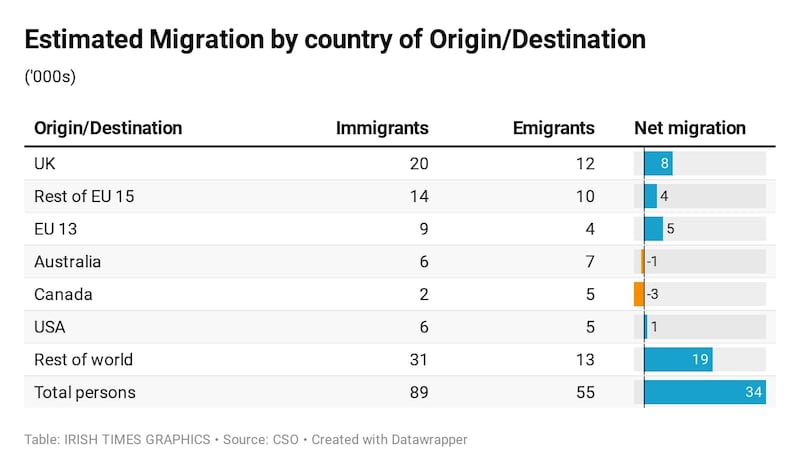The number of Irish people emigrating from Ireland has overtaken the number of people returning again.
An estimated 29,000 Irish nationals emigrated in the year to April 2019 compared with 26,900 who returned to the country during the year, according to figures published by the Central Statistics Office.
This marks a return to net outward migration after a year when, for the first time in nine years, the number of Irish people returning to live in Ireland from abroad marginally (100) overtook the number emigrating.
The net outward migration of 2,100 during the year – compared with net inward migration of 100 in 2017/2018 – contrasts starkly with the net inward migration of foreign nationals moving to Ireland.
The number of non-Irish nationals moving to Ireland exceeded the number leaving by 35,800 during the year, an increase of 5.6 per cent on the corresponding period for the previous 12-month period.
Some 88,600 people moved to Ireland during the year, down almost 2 per cent on the previous year. Of these, 26,900, or 30.4 per cent, were returning Irish nationals.
The 54,900 people who emigrated from Ireland, both Irish and other nationalities, during the year was the lowest figure recorded since 2008, down 2.5 per cent on the figure covering the same period last year. The number of emigrants peaked at 83,000 in 2012.
Population change
The population increased by 64,500, or 1.3 per cent, to 4.92 million people at April 2019. There were 622,700 non-Irish nationals – up almost 5 per cent – in the State, accounting for 12.7 per cent of the population.
It was estimated that there were almost 1.4 million people living in Dublin in April, or 28.4 per cent of the population. All regions recorded a population increase, ranging from the Mid West with an increase of 2,600 people, or 0.5 per cent of the population, to 25,100, or 1.8 per cent, in Dublin.
The United Kingdom remains the most popular country for emigrants from Ireland.
Migration to the UK increased by almost 2 per cent to 11,600 during the year, bucking several years of decline, while the numbers moving from the UK to Ireland fell by 2 per cent, to 19,700.

Immigration from "rest of world" countries (which excludes the UK, EU, Australia, Canada and the US) rose from 27,400 to 31,400, an increase of 14 per cent.
There was a surge in emigration to Australia, as the numbers leaving Ireland for the country increased by 2,000 to 6,500 in the year to April 2019 - a figure last recorded in 2015.
The numbers heading to Australia had been declining or remained flat in the intervening period. Emigrants leaving for the country peaked at 17,400 in 2012 in the wake of the economic crash.
The number of people returning or immigrating from Australia declined from 7,200 to 5,800.
The Trump effect
Emigration to the United States has steadily decreased during Donald Trump's presidency. The numbers fell to 5,200 in 2019 from 5,800 last year and 6,500 in the 12 months to April 2017, three months after he took office.
Some 6,200 immigrants came from the US in the year to April, down by 15 per cent from 7,300 the previous year. The number heading to Canada jumped by 1,000, or 26 per cent, during the year.
Emigration amongst men increased from 26,400 to 28,100 – up 6 per cent in the year – compared with a decrease amongst women from 30,000 to 26,800 – a decline of 11 per cent.
The number of people leaving Ireland with third-level degrees rose from 26,500 to 28,300 during the year. The number has fluctuated over the past seven years, from 29,900 in 2013 to 31,000 in 2015 to 27,900 in 2017.
The CSO statistics show a trend towards a “brain gain” rather than “brain drain” since the economic crisis.
The number of third-level graduates moving to Ireland has steadily increased in recent years, from 32,000 in 2013 to 53,000 in 2019. The increase amounted to almost 8 per cent in the 12 months to April 2019.
Forty-somethings accounted for the largest segment of the population with 731,000 followed by thirty-somethings (727,800) and babies and children up to the age of nine (667,500).










